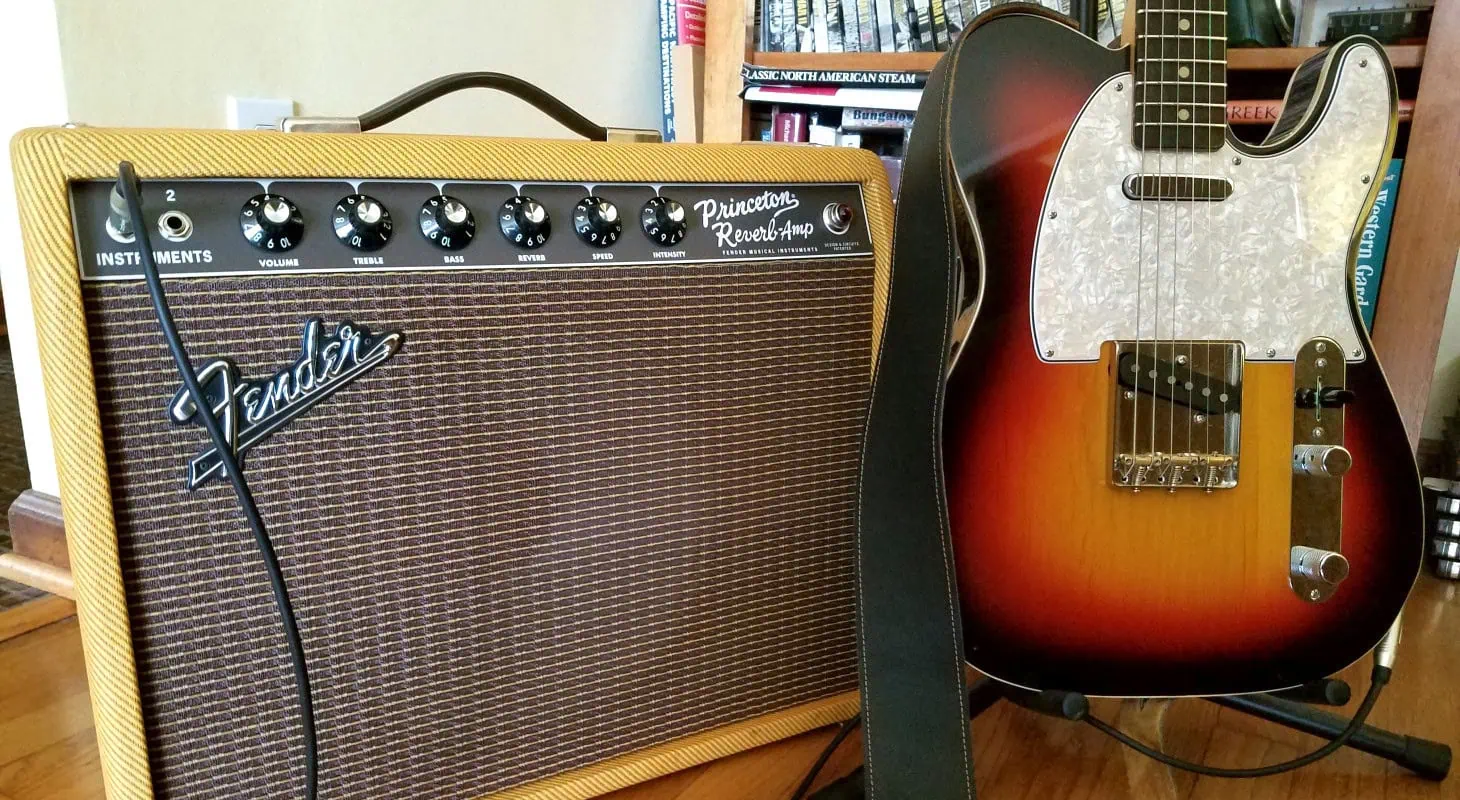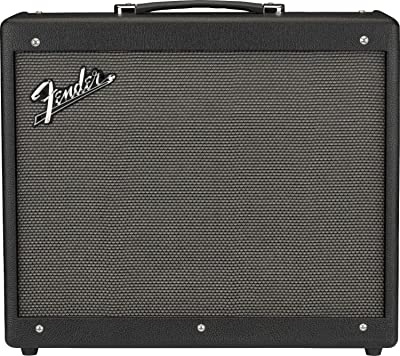There’s a common saying among Telecaster lovers: “Leo got it right at the first attempt”. Well, that is because the Telecaster is, for many of us, the most versatile, reliable, and usable guitar ever made. For short, the definitive solid-body electric guitar.
With its iconic tone, signature twang, and unrivaled playability, the Fender Telecaster has continued to define guitar music for decades.
But how can you get the most out of your instrument? What’s the right amplifier to plug it into and get the twang, body, rhythmic percussive tone, and snap from your beloved (or brand new) Tele?
Top 3 - Amps for Telecaster
Preview | Product | Price |
|---|---|---|
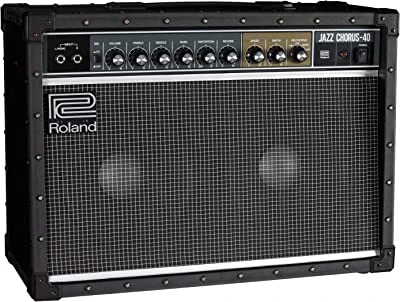 | ||
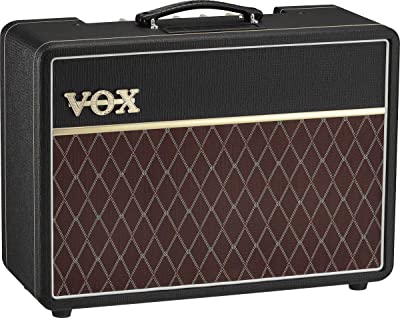 | ||
 |
The interaction between a guitar and an amplifier is the foundation of your tone. Certain amps are better suited to particular types of guitar. In this guide, you’ll find the amplifiers that naturally work best with a Telecaster.
Yes, I’ve done the heavy lifting for you and played my Fender Custom Shop Telecaster through a myriad of amps to bring you the answers you need. The list will be a compass to navigate the vast waters of ampland.
Are you ready? It’s time to get twangy!
Let’s Define the Telecaster Tone
Before we get into the amp models, let’s define what makes the legendary Telecaster tone. I will address some different models and customizations as well, but the article is directed toward traditional, two-single-coil, 3-way-switch, volume-and-tone Telecasters.
So, to begin with, I’m not blowing any scoop by saying that the Telecaster is a treble-oriented guitar. Yes, the famous twang, which for some has to do with the metal plate below the bridge pickup, is the reason why country players love the Telecaster.
Another very important aspect of a Telecaster tone, especially if you’re playing a maple-neck-and-fretboard model, is the edge. The Telecaster is usually razor-sharp in the upper mids, therefore, it can cut through even the densest mix.
Not so well-known, but very important still is that the Telecaster has some great lows and lower-midrange. Yes, you can hear it all over classic albums and it’s something that gets most people by surprise. We’ll get to it in a minute, but it’s important to fiddle around with your knobs and switches before calling it a day with this guitar. It hides some amazing tones under the hood.
Finally, the one thing you need to be careful about when playing a Telecaster is that, especially entry-level models, the sound can get too sharp, shrill even. So, whenever you’re picking up an amplifier for your Telecaster, you need something that can push the mids, tame the highs, and enhance the lows.
Oh, and don’t worry, there’s an extra space in this piece for amp+pedal combinations that really work. So, stick to the end for those tips.
You’re in the right place, your one-stop source for all things Telecaster.
Oh! There are Controls too!
Most people I know that play a Telecaster go for the bridge pickup with everything on ten and work the sharp edge of the guitar’s tone to rip the fabric of the world. Although I agree that’s the Telecaster signature sound, there’s much more than meets the eye on your guitar.
Let me give you some useful combinations:
Bridge pickup wide open - This is the usual all-in-ten kind of scenario in which you’re getting the best of your guitar’s signature sound. It works great when you’re playing country, rock and roll, or even as a solo configuration in any style. Bear in mind you can use your tone control to tame the highs and the volume control to control shrillness.
Middle position wide open - The middle position is definitely my favorite. You get more darkness in your tone but also a beautiful low midrange that can make any line instantly vibey. I suggest you play with your volume knob until you find the sweet spot. Then, just funk it up, play complex neo-soul chords, or just big open chords, the guitar will feel huge.
Neck pickup wide open - The neck pickup in most Telecasters is a forgotten hero, a useless ornament to a beautiful pickguard. Yet, if you want to play some Queens of the Stone Age-friendly riffs, blues, or even do some fingerpicking getting a mellow, sweet tone (enhanced with a rosewood fretboard), it’s the way to go.
Bridge pickup zero tone - The tone knob on your guitar is another unsung hero. Yes, most people leave it wide open all their life. Well, if you put it in zero, add gain to the signal, and play with the volume in ten, you have a great creamy tone to play leads for days with. Yeah David Gilmour rang, he wants to know the recipe.
Middle position halfway - This is another great setting for your Telecaster. Just dial the knobs at 5 and put the 3-way switch in the middle. This will make you feel you’ve tamed the beast. The guitar becomes this mild-sounding, beautifully sweet instrument that can handle complex chords and fast changes easily.
Choose Your Destiny, Define Your Style
Over the decades, the Telecaster suffered many modifications. From the CuNiFe Wide Range experiments in the seventies to the metal-approved active-pickup models, to the pristine-sounding noiseless pickups, you can see a Telecaster virtually on any stage.
Some wild examples are John 5, Jim Root, and Ritchie Kotzen. These players add obnoxious levels of distortion to their telecasters and aren’t afraid of shredding the night away.
Yet, most players play the Telecaster as an open canvas. Yes, it’s a songwriter’s tool. If you think about it, the Telecaster is the rhythm player instrument while the Stratocaster is the lead guitar. The perfect way to see this is watching The Rolling Stones play live.
While Keith plays a Tele, Ron plays a Strat.
Also, there are countless examples of rhythm players with Telecasters from Springsteen to Joe Strummer to Andy Summers to Black Francis.
So, the good thing about the Telecaster is that it’s truly an army Swiss-knife kind of guitar. If you know your way around it, you can make it howl, purr, or scream. Yes, the secret ingredient for all those tones is the kind of amplifier that you plug the guitar into.
Best Amps for Telecasters & T-style Guitars!
1. Roland JC Series
Roland’s JC-120 has been used by many great guitarists for over 40 years now, including players as diverse as Zakk Wylde, Johnny Marr and Mac DeMarco.
In the rare case you’re not familiar with it, the myth around this amp is that it is as clean as amps get. Nothing is cleaner-sounding than the JC-120. That is also saying that, as a solid state amplifier designed for jazz legends who need utterly clean sound, it was a complete success.
The counterpart to that successful design is that it can also be described as somewhat cold or stale if you’re very used to the tonal complexity and the warmth of tube amplifiers.
The truth is, it's a truly fantastic amp, but not everyone needs or wants such a big piece of gear.

My Trusty Companion: The Legendary Roland JC-120
The JC-40 takes everything that is great about its big brother and puts it into a more compact form.
The JC-40, although smaller, certainly doesn’t lose any of the clean tone of the 120. For Telecaster players, having an amp with a great clean tone is almost a must. If you play a lot of jazz or country with your Tele, I believe you will instantly fall in love with the clean tone of this amp.
For the blues and rock players, the JC-40 is a different story. The amp comes with distortion, moreover, Roland recently updated and overhauled that part of the circuit to make the amp more versatile. The result, though, is of the same fizzy quality as it always was. I wouldn’t say that the JC-40 or JC-120 are suitable amps to play distorted with the onboard circuit.
That said, both are great pedal platforms to sculpt your dirty tone with. In that sense, the difference between the midrange of the 10” and 12” speakers is noticeable. If you’re like me and millions of players around the globe, you’ve been playing through 12” speakers all your life. Playing through a 10” speaker amp sounds (and feels) different.
If you want to get some more twang out of your Tele, the JC-40 also has a bright switch. This quickly adds some great sharpness and brightness when you really need it. Although it’s a great addition for dark guitars, if you couple this switch with the bridge pickup you’ll awaken a savage beast that’s hard to handle. Preventing the high-end from going into shrillness isn’t easy, but it can really open up a dark neck pickup.
I think the main point of interest on the Roland JC-40 is the vibrato/chorus effects. This is genuinely one of the best chorus effects I have heard on an amp. It’s no wonder that it ended up getting made into a guitar pedal that would revolutionize the world of guitar for decades to come. Yes, I’m talking about the 1976 Boss CE-1 Chorus pedal; the one that started it all.
The chorus can either be set to a fixed setting or manual, allowing you to adjust the speed and depth. But what really makes the chorus effect great is how the amp goes about applying it. The JC line is made of stereo amplifiers that take the chorus and vibrato effects to the next level. You get this immersive experience that gives settings like the middle position in your tele an almost 3D quality.
How does it work? I’m glad you asked. Instead of just layering the effect on top of your guitar signal, it actually combines the two. One speaker will reproduce a dry signal, while the other a wet one. This creates a much more natural-sounding, vibrant chorus effect.
So, to summarize it, if you’re a clean amp lover and will play your guitar with pedals, then these amps are a must-check. On the other hand, if you want something more organic, vibey, and with the warmth of tubes, you might find it elsewhere.
PROS
CONS
2. Vox AC Series
If you have been playing guitar for long enough, you probably know the name Vox. And if you are familiar with the Vox sound then you already know what to expect from the legendary AC series.
It’s made of six amps, the AC4, the AC10C1, the AC15C1, the AC15C2, the AC30C1, and the AC30C2.

Vox AC30C2
These amps go from 4 watts to 30 watts of pure British tube tone. They all carry the signature sound of the British invasion but all of them have different headrooms and price tags, so it’s safe to say there’s a Vox AC for every budget and player.
Let’s get started with the AC4 and the AC10C1, the smallest on the lineup. These are sort of simplified versions of the real deal with a simple 3-band EQ, gain and volume but no tremolo, or effects loop. The AC10 comes equipped with digital reverb, which is great to add space and room to your playing.
The reverb is especially effective when playing melodies and licks. It is very tight and responsive, so notes don’t bleed into each other and are still crisp and clear.
These are great for players who need to have the full sound of a valve beast at bedroom levels. You can truly get that crunch that’s full of razor-sharp midrange and is so distinctive of Jimmy Page’s early Yardbird days or Jeff Beck in the same position.
This is always with your bridge pickup and the controls wide open.
If you roll back the volume and go to both pickups, things get more chord-friendly and you have a distortion pedal in your volume knob, ready to go into mayhem mode at any second.
The tone on this little tube amp is about what you would expect from a Vox amp. It has a lively, bright top-end with a healthy amount of bottom that helps to round out the sound a bit.
Turning up the gain really brings out that British style crunch. Think Jeff Beck or Keith Richards and that is the sound you get.
What really impressed me on the smaller amps was just how loud they can get. They’re only a 4 and a 10-watt amp, but they still pack quite a punch.
Moving over to the bigger iterations of this classic model things get bigger and also meaner. The 1x12 models of the AC15 and AC30 are great pub amps if you play with pedals. They can be taken to the edge of breakup and that’s when your Telecaster will become alive.
Yes, the gorgeous midrange that the pushed el84s give your guitar takes sound to the next level.
Also, these amps sound less compressed, and thus, more organic and natural, and will also give you more headroom to play with pedals. You can make that sweet natural overdrive your favorite distortion by adding a pedal over it.
In these scenarios, the bridge and neck pickup will take you instantly into rock and blues territory respectively and effortlessly.
For bigger venues or more headroom, you can get the 2x12 version of either of these amps. You have to beware, though, that a 2x12 amp is not small or comfy to move around. That said, the low-end of your Telecaster and overall tone will grow dramatically.
For example, if you pile an overdrive and a fuzz through a 2x12, and play with the bridge pickup and the volume wide open, you’re instantly rocking. Adding an octave on that could mean going full Jimi Hendrix or Jack White style.
Finally, I put my effects through these amps’ effects loops and the result was a lush mix of the onboard tremolo and reverb with some clean delay trails and phase swooshes.
Speaking of which, a very wet sound full of reverb and delay with the tele in the middle position and all controls halfway up will get you into a nice psychedelic world that would make Syd Barrett jealous and happy.
Regarding the AC4 and AC10, if you choose these amps, you will be getting a lot of volume and the quintessential Vox tone for your Tele without bothering your neighbors. That said, I wouldn’t use these amps for any gigs, but you can definitely use them in the studio.
You will be getting a lot of volume from this small amp without bothering your neighbors. I wouldn’t use this amp for any gigs, but you can definitely use it in the studio.
The bigger versions will give you more options to play with and more headroom to use with pedals but aren’t at all neighbor-friendly when cranked. That said, you can compete with a loud drummer easily, especially with the 2x12 version.
If you are a Telecaster player, the AC line by Vox is a fantastic companion. It complements and emphasizes the Telecaster sound wonderfully. The bigger options allow you some clean headroom for extra pedals, and also give you that classic, mid-infused Brit invasion tone without much tweaking.
PROS
CONS
3. Fender ’65 Blackface Reissue Series
If there is one way to get that true Fender sound with your Telecaster, it is to play it through a Fender amp. Well, the Blackface series of valve Fender amps, known as ‘65 Blackface reissue is the highest you can aim for that Fender-on-Fender celestial tone.
The line features four amps going from 12 to 85 watts of pure clean valve power. It all starts with the 12-watts ’65 Princeton Reverb, then comes the 22-watts ‘65 Deluxe Reverb, the 45-watts ‘65 Super Reverb, and finally the 85-watts ‘65 Twin Reverb.
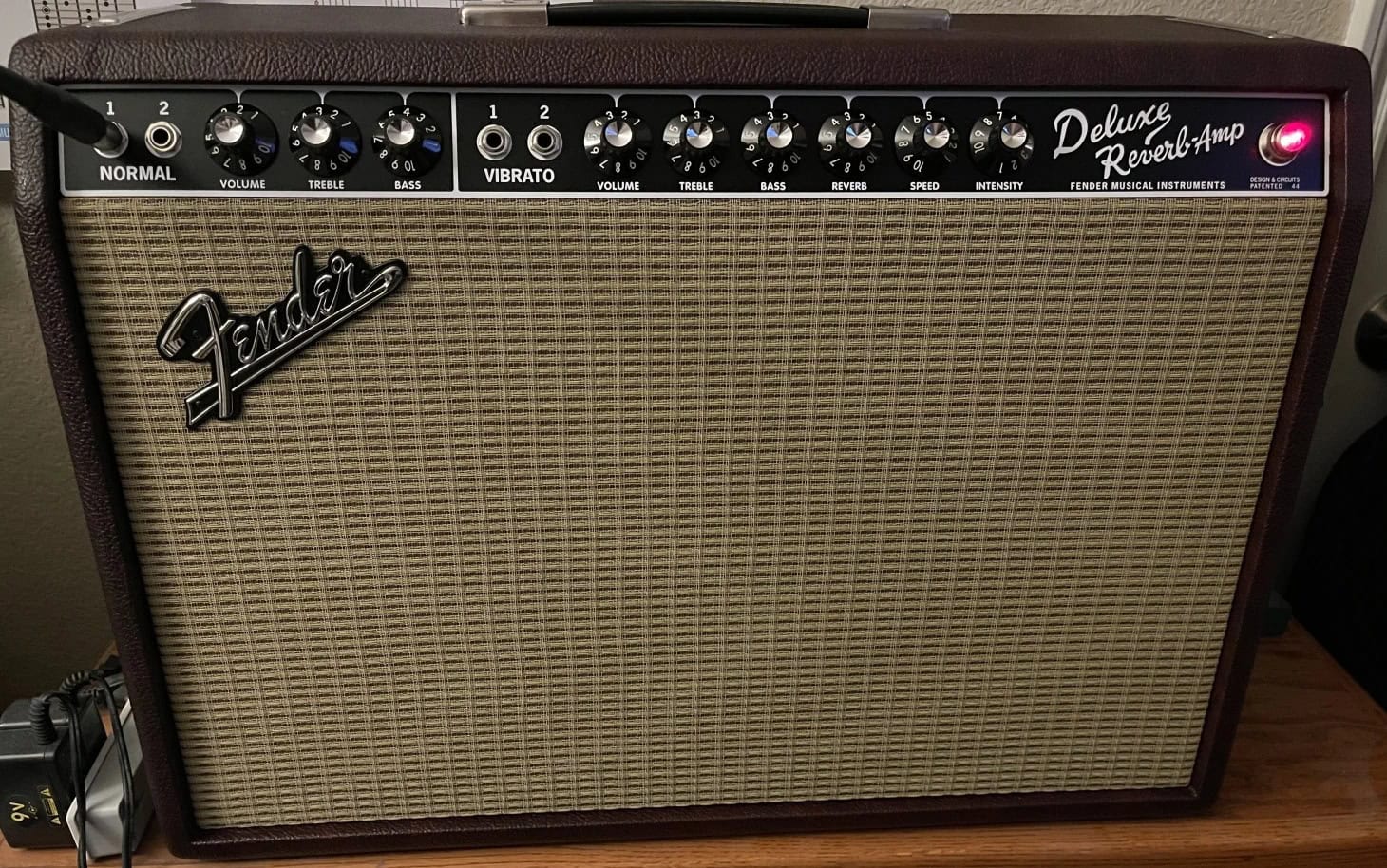
Fender '65 Deluxe Reverb
The one characteristic all these amplifiers share is that they can reproduce the warm, clean, and organic Fender tone that’s a match made in heaven for any and all Telecasters.
Yes, there’s an iconic sound that can only be achieved by playing a Telecaster through a Blackface amp that you’ve heard a million times before in countless records. All these models can give you that tone with different levels of headroom and with different features.
Let’s get started from the beginning. The ’65 Princeton is well-known for its clean tone, and for good reason. The clean tone is crisp and sweet. Even before making any EQ adjustments, I was drawn in by just how good the amp sounds clean.
Pushing the amp into distortion is a similar situation. This amp has both bark and bite. It is that classic ‘70s rock sound.
The best way to hear what a Princeton and a Telecaster can do is to listen to Tom Petty sideman, guitar legend Mike Campbell. He was the man behind the guitar licks in every Tom Petty super hit from “American Girl” to “Free Fallin’”.
Well, if you plug your guitar into a Princeton and set the volume between 3 and 5 and go from the bridge to the neck, you can play everything from big rock chords to small neo-soul octaves to bluesy licks easily.
Moreover, setting the amp beyond 8, you’re into a ferocious overdrive and distortion mode that’s stellar to play leads and handle all your sounds from the volume knob.
If you want a more modern sound, the amp also plays really well with pedals. That said, you might feel that the Princeton has little headroom to let your pedals shine. Plus, the 10” speaker might not be the sound in your head.
In that case, you’re ready for the next step, the Deluxe Reverb. This 22-watt valve powerhouse is, for many, the pinnacle of Fender amplifiers in a portable, powerful, and sturdy model.
The big difference between the Princeton and the Deluxe is that this latter one is a two-channel amp. You have a normal and a vibrato channel. They’re voiced differently. The normal channel is darker while the vibrato channel is a tad brighter.
Whichever voice suits you the best, you can dial everything at 5 and just have fun for an entire practice session. But that’s not all, because this amp is also a superb studio tool. You can use it pristine clean with your guitar in the middle position letting chords drip with warmth and a bright top end.
On the other hand, if you want compressed and organic tube saturation, just dime the volume control, put that Telecaster in the bridge position, and play it loud and proud. Furthermore, in that scenario, just flick the pickup selector forward and go into the perfect blues lead tone handling brightness with your guitar’s tone knob.
Finally, add some reverb and tremolo and play some Spaghetti Western licks, you might feel like the spirit of John Wayne takes over the scene.
But speaking of reverb and tremolo, I’ve never had a better experience with a Blackface Fender amp than playing a Super Reverb. This is, to me, the most spacious, deep, and pristine amp in the line.
Although not everybody is familiar with it, it oozes power pushing tone forward with the 4x10” speaker configuration. This is both a pro and a con.
On the good side, it sounds like nothing else because the 10” speakers don’t have the same midrange 12” speakers do. Therefore, the lows and highs are more pronounced making your Telecaster shine through.
On the other hand, it’s even heavier than a Twin Reverb because the four 10” Jensen speakers occupy more space making the size of the amp huge.
In my experience, and to my ears, you won’t get that kind of low-end anywhere else on this amplifier line (or the market, maybe). The Super is, to me, the ultimate Fender studio amp because it can give you the best of the clean and the dirty without losing an inch of presence and personality.
Also, at 45 watts, it’s more usable at high volume than the colossal Twin Reverb that boasts 85 watts of pure valve power through a 2x12 configuration.
The differences in tone between these amps are all in the midrange. The response to pick attack and fingerpicking are very different from a player’s perspective. While the Twin Reverb bites, barks, and gives you that quintessential sharp midrange, the Super is more scooped and has the biggest low end you’ve heard in a Fender amplifier ever.
Both these amps are exceptional choices for your Telecaster if you have the budget and the room for them. Moreover, they shine with and without your pedalboard. The headroom and natural overdrive are easy to get by just changing your pick attack and guitar controls.
Perhaps, the only caveat I have to speak about these amps is to beware of the effect the bright switch has on your guitar. It can be a great way to open up the tone of that neck pickup but my favorite experiment was matching that switch with the tone knob of the Tele.
If you play the bridge pickup with the tone wide open and the bright switch ON, you might hurt yourself and others because of the piercing highs. This is especially true for maple-fretboard teles. That said, put the tone control in zero, use some distortion and that bridge pickup and you have the most soaring lead tone you’ve ever heard.
Nothing sounds more iconic than the Telecaster through a Blackface amp. They’re not the most affordable or portable on this list, but you’ll surely be in Fender heaven if they fit your budget and you have enough room for them.
PROS
CONS
4. BOSS Katana Series
The BOSS Katana series might be one of the most versatile budget amps today. They are extremely capable and powerful modeling amps, perfect for any guitarist that plays a variety of styles and genres.
The line is made of three very usable gig-friendly amps, the Katana 50, the Katana 100, and the Katana 100 Artist.
As you might know, modeling technology digitally emulates the sound of legendary equipment. Well, the third generation of the Katana series comes with six different amp models including brown, lead, crunch, pushed, clean, and acoustic.
These models go from the Marshall-friendly, ‘80s-infused brown mode and face-melting lead modes to the mild crunch and pushed (based on a pushed combo at the edge of breakup) modes. Finally, the clean and acoustic modes are great for the pristine sounds the Telecaster can deliver with ease.
I tried the high-gain setting with the bridge pickup of the Telecaster and, although the result was a little too bright to my taste, the tone knob became very handy to tame those frequencies. The middle position was awe-inspiring. Adding some delay and reverb, the amp took me straight into trip-hop territory.
Yes, the Katana mixes these amp modes with the best of Boss’ worldly-renowned effects. You can add the onboard ones and also use the app to broaden your tonal palette.
This versatility lends itself quite well to anyone that plays a Telecaster. Telecasters are themselves, versatile guitars. The Katana amps will enhance your Tele’s sound rather than change or override it. The Tele spirit, the razor-sharp tone, the body, the twang, the sparkling high-end, and the particular midrange are all there; regardless of the Katana model you choose.
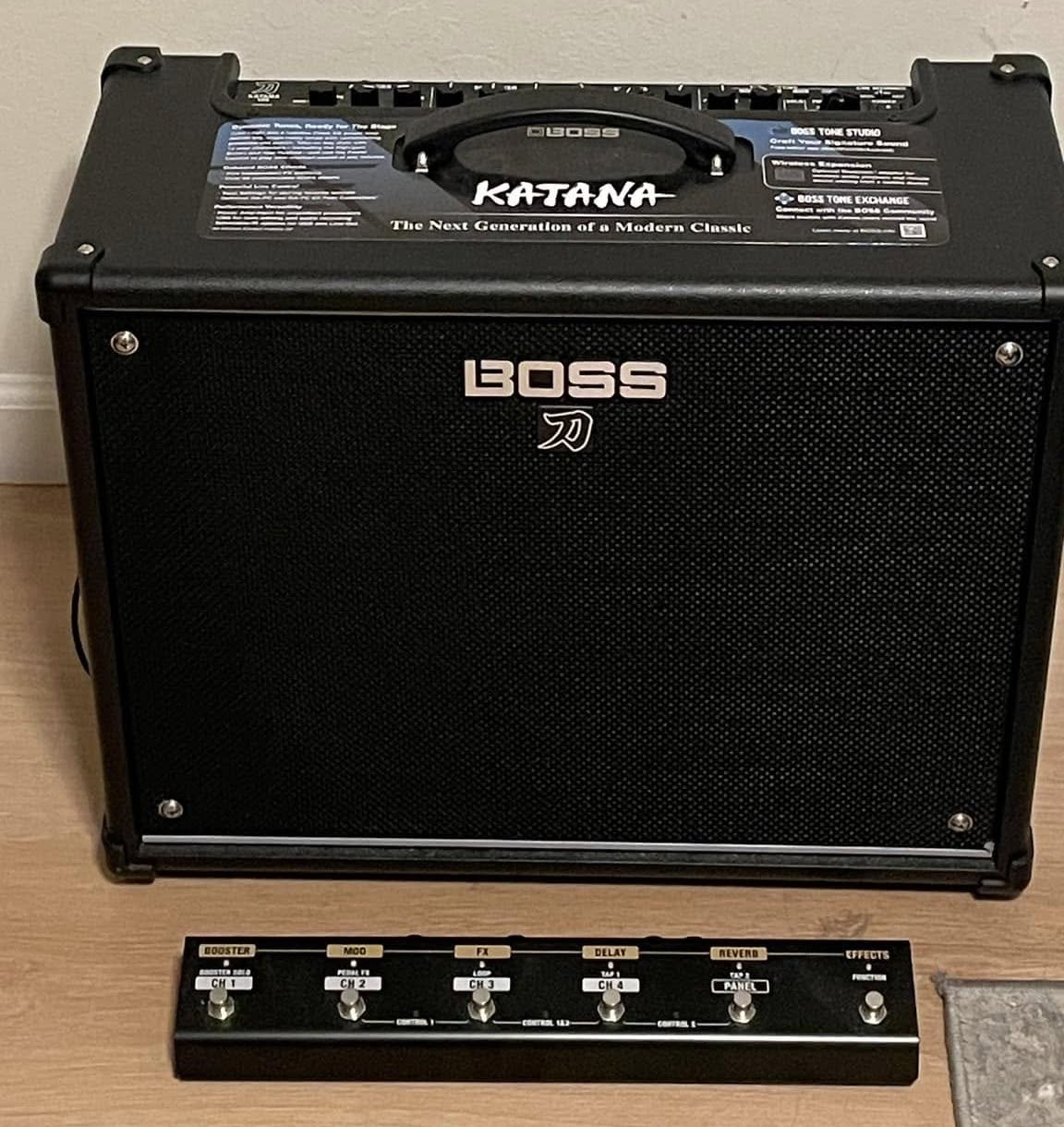
BOSS Katana 50 Gen 3
With 6 amp voicings and 60 effects, you can play practically any genre of music using the Katana. And from 50 watts to 100 watts, these things are definitely gig-ready.
I really liked the power control feature as well. This lets you cut the power by half, 25-watt, or even down to just 0.5-watt. This makes it a great amp for quiet practice sessions with your Telecaster and eliminates the need for a second, smaller amp for home use.
As for what the amp actually sounds like, there is often a concern that it will sound artificial, being a modeling amp. But from my experience with the amp, I think BOSS has done a really incredible job.
Each of the amp voicings sound very natural, you can make the most out of every Telecaster setting. For example, I tried some ‘90s approved Oasis songs with big open chords in the crunch, and the middle pickup position and it all sounded huge. Same happened when I added some delay, worked with the lead mode and the bridge pickup.
Let me also tell you that the new addition for the third generation of Katana amps, the pushed mode, playing with the neck pickup and a tube screamer with generous reverb, took me to playing soulful blues in no time.
Finally, the psychedelic tones I got with modulation effects and the middle position could have been approved by Kevin Parker, Tame Impala’s mastermind.
The feeling I got playing with my Tele and this amp was that, if you can think of a sound, this amp will probably be able to recreate it. And if you don’t find what you are looking for from the long list of effects, you can easily change and add effects using the BOSS Tone Studio software.
I actually don’t know how BOSS has managed to make such an incredible-sounding, versatile amp while keeping it so affordable. I have never played a better amp that is as affordable as the Katana series.
I do wish that a footswitch was included, however. I would recommend investing in a footswitch like the FS-6 if you are planning on gigging with it. Speaking of which, gigging guitarists will be better off with the Artist amp and its XLR direct out with ground lift.
Further reading: BOSS Katana vs Positive Grid Spark (a much more in-depth take on the Katana)
PROS
CONS
5. Bugera V22 Infinium
The Bugera V22 Infinium is a great amp if you are looking for a British sound. With a great clean channel and a matching overdrive channel, it performs really well whether you’re playing some mellow jazz or kicking into high gear for a loud rock gig.
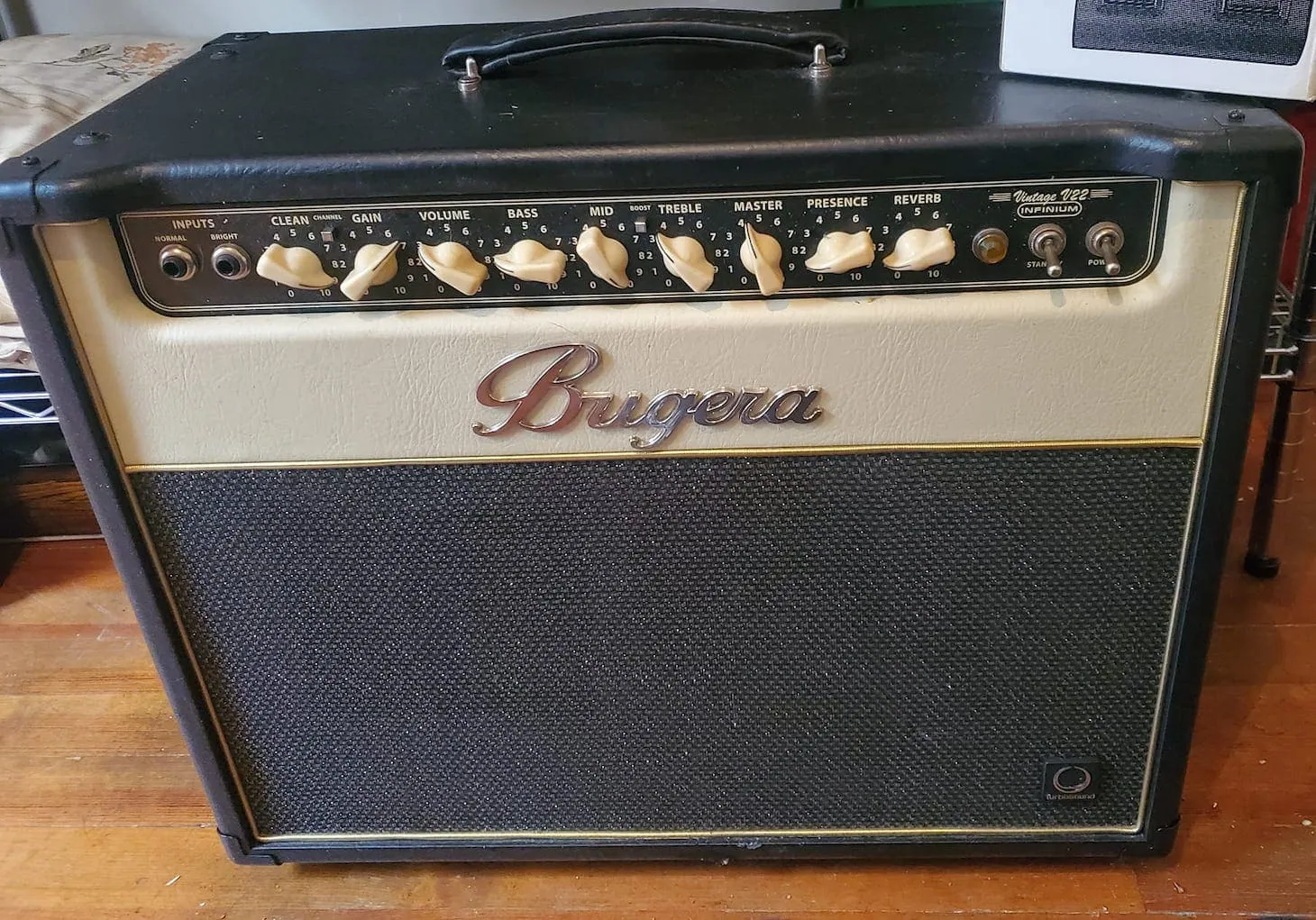
Bugera V22 Infinium
On the normal channel, the clean tone is smooth, a bit warm, and nicely rounded. This is great for those mellow jazz jams. For example, dialing in some reverb and pushing the lows, I was able to get some nice jazz tones with the tone knob close to zero and the middle position.
Likewise, the neck position gave me a great bluesy tone. I did use the mild overdrive of the amp and gave it some overdrive from my Tube Screamer and the midrange became alive taking me into bluesy, SRV-friendly, Hendrix-approved territory.
I tried the entire pedalboard into the input of the amp and used it as a pedal platform to propel my distortion and fuzz tones forward and had a lot of fun. Yes, it doesn’t sound as 3D, deep, and organic as a blackface Fender, but it has a way more affordable price tag too.
It would be unfair to ask those tones from this amp.
That being said, I had a blast. The clean headroom is huge, perhaps it is because it has an 80-watt speaker, which can be harder to drive. Although I missed the edge-of-breakup and broken tones of my Deluxe Reverb (also 22 watts), there was a lot of space to play with my gain stages. In this scenario, the bridge pickup with generous distortion took me straight into riff land.
There is also the option to plug into the amp’s Bright input. As you would expect this brightens up the sound a bit and gives your guitar a bit more twang, especially great if you play country with your tele. With the guitar in the bridge pickup, you have a beautifully bright tone that’s sharp enough to shine and cut any mix, making it arguably the best amp for country that you can pair with your Tele in this price range.
But the Bugera isn’t a one-channel, it’s a two-channel amp with included footswitch. So, I went over to the dirty channel and did what most of us do when trying out an amp, set the gain to 10. The result was a usable distortion not thick enough to be metal material but grainy enough to be in a Marshall-friendly territory.
In this scenario, the Telecaster’s bridge pickup became this powerful beast capable of riffing, punk rocking, rock and rolling, and much more. But that’s not all, because with my pedalboard before the amp I could add some more gain and play rocking leads or dirty blues.
The reverb added to this tone gave me a more spacious sound, enhancing the organic response of the tubes.
Switching between channels as well as activating the reverb is also made easy with the included footswitch. I like the footswitch quite a bit with its big buttons and LED indicators.
The amp also gets quite loud. You won’t have any trouble playing gigs in small clubs with this amp. You can also cut the power by half when practicing if it gets too loud.
I am a bit concerned about the tubes used in the V22. They are fairly cheap, Chinese-made tubes. I understand the need to keep production costs down. While the tubes do sound great, lifespan is certainly something to keep in mind.
It is also quite heavy for an amp of its size. If you want something a little more lightweight and compact, or just a practice version of the V22, the V5 Infinium provides the same quality in a smaller package. You can check out our review of the V5 to get a better idea.
PROS
CONS
6. Fender Hot Rod Series
The fourth version of Fender’s Hot Rod series amps is a budget-friendly version of the classic Fender sound that’s built to endure the hardships of the road.
The lineup is made of four amps, the Pro Junior, the Blues Junior, the Hot Rod Deluxe, and the Hot Rod Deville.
These amps go from 15 to 60 watts, and despite the differences in speaker configurations, wattage, and control layouts, they carry Fender’s DNA and signature sound.
The smallest in the pack are the Pro Jr and the Blues Jr.

My Blues Jr!
The Pro Jr. packs a 10” speaker and a very straightforward set of controls with just volume and tone knobs. The tone can be thought of as a filter similar to the one on your guitar and the volume is, essentially, a gain knob, just like the one you’d find on your guitar.
The clean tone has that classic Fender sparkle and chime. Every note shines and chords ring out quite beautifully. As you increase the volume knob, rocking tones come to your hands by themselves. I mean, even if you’re not a Stones fan, you’ll try some Richards-approved moves with this setting. It’s the Stones’ spirit taking over.
Although it’s not such a pedal-friendly amp, if you want your amp to sound pushed, organically broken, and kind of dirty, this is the perfect choice. Likewise, the volume knob on your guitar can clean up the tone.
The Blues Junior is a different kind of amp with a three-band EQ and a master volume knob. Moreover, the FAT switch works like a boost or a somewhat subtle second channel. Also, you have some more headroom in case you want to use pedals instead of your volume knob to move through different gain stages.
Speaking of which, where the Blues Junior really shines in my opinion, is when playing with a lot of gain. For such a small amp it packs quite the punch. At low gain, you get a very delicate blues sound. This is especially true playing with the bridge and neck pickups respectively. The bright top-end and twang of the Telecaster gets even sharper with gain. The neck pickup gives the tone the perfect darkness you need to play sweet blues leads.
With the pickup selector in the middle position, just turn the gain up and you easily start to reach a heavier, Stevie Ray Vaughn type of blues sound. Especially once you activate the “fat” switch to boost the mids and output.
The spring reverb also sounds amazing. It is very natural and vibrant and doesn’t get in the way of the notes. Melodies and chords sound equally impressive with the reverb turned up.
The bigger incarnations of these amps, the Hot Rod Deluxe and Deville are a 1x12 and 2x12” version of the Blues Jr circuit but with two distinct channels. Furthermore, these amps feature the More Drive (clever name, huh?) to go into solo territory.
So, if you want an amplifier that can be driven to the edge of breakup organically at pub volume, the Pro and Blues Jr are the way to go. For bigger venues and to compete with a loud drummer, the Hot Rod Deluxe and Deville are more suitable.
Also, if you play with pedals, the Deluxe and Deville give you more headroom to use the clean tone as a base for sculpting your own tone with different gain stages.
I think the Hot Rod series amps really make a Telecaster sing. They bring out everything great about such a guitar while adding a lovely bit of color.
I think the Hot Rod series offers great amps if you are going on a small club tour. They are easy to take with you and quick to set up.
PROS
CONS
7. Fender Mustang GTX Series
The third Fender amp series on today’s list, the Mustang series, is unlike the other two entries. Where amps like the ’65 Princeton Reverb and the Blues Junior IV are suited to one sound or another, amps like the Mustang GTX 100 are far more versatile.
Speaking of which, the line is made of a headphone amp (the Mustang Micro), a desktop amp (the Mustang LT40S), and the two giggable units, the GTX50, and the GTX100.
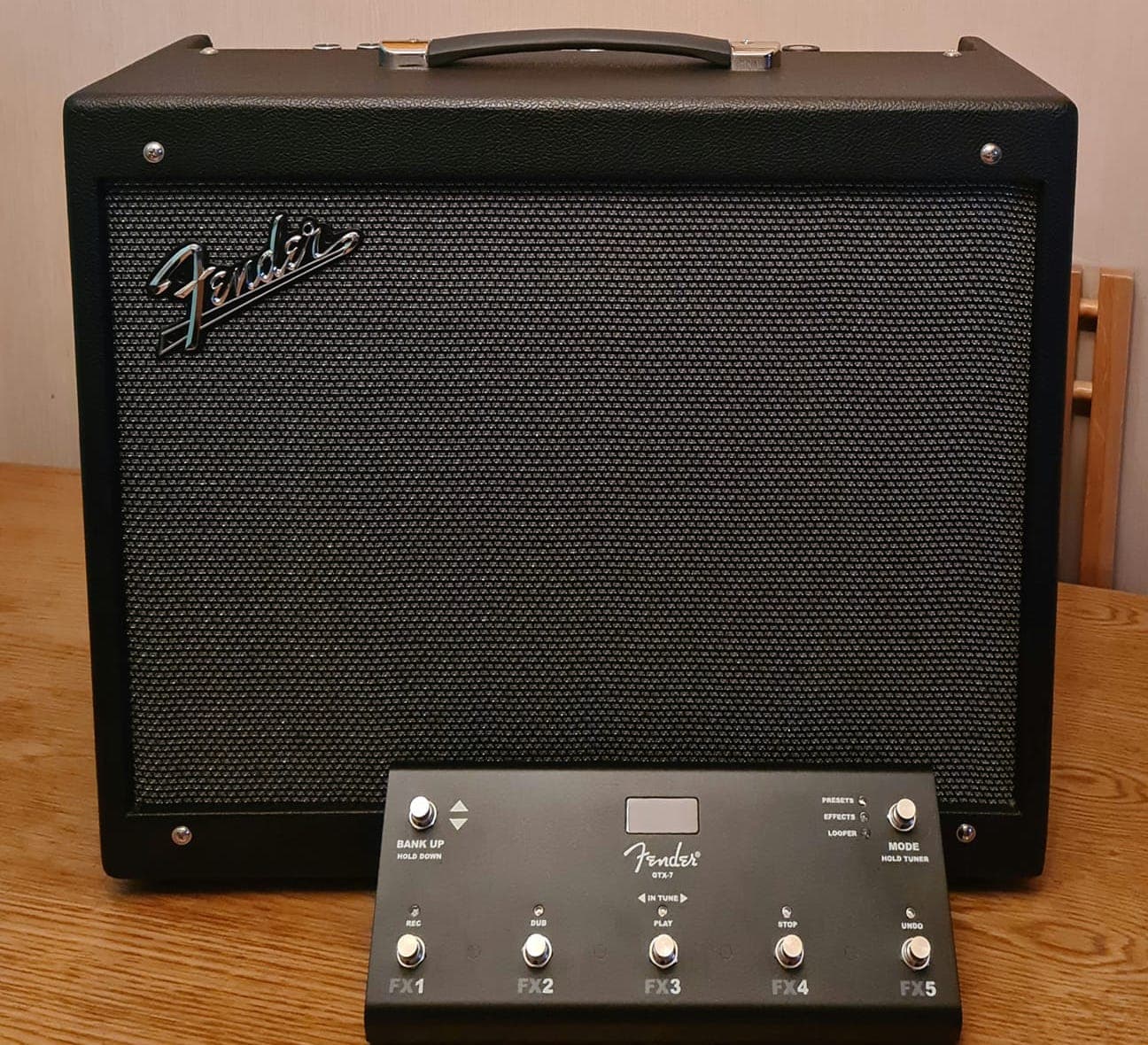
Fender GTX100
Similar to the BOSS Katana MKIII series, this amp is also a modeling amp. It does go quite a bit further, however. Featuring 40 amp models, dozens of effects, and 200 presets, it is a true all-in-one amplification powerhouse.
You really aren’t limited by what the amp can do, but your own imagination. If you can’t find the sound you are looking for among the presets, you can easily mix and match effects and amp models until you get the exact sound you are looking for.
But that’s not why this amp is on this list. The reason is that it packs a faithful recreation of all the legendary Fender tube-driven amps, including everything from the Blues Junior to the Custom Shop-only models like the uncanny 3x10 Vibro King, for example.
On top of that, you can choose amps like the Silver Jubilee and wear those fluo tights and basketball sneakers to play Spinal Tap tunes all night. Speaking of playing at night, you can plug in your favorite headphones and have some silent practice sessions or use the dual XLR outputs to play in your favorite pub without even mic’ing it up.
Fender has also done a tremendous job of recreating all of these amps and effects. To me, the GTX 100 sits right up there in terms of sound quality with modeling amps like the Katana or even more expensive modelers like the AX FX or the Kemper. This is especially true for the Fender models.
I never felt like any of the amps or effects were lacking in quality or felt stale while playing with the Mustang series. If you are playing a guitar like a Telecaster this is really important.
So, I went from hitting the guitar with the thumb, slapping some country licks to playing ferocious leads with generous gain and delay by just turning the preset wheel without even leaving the bridge pickup at all. Furthermore, adding some more gain and more delay I was stepping on Mr. Gilmour’s toes. Metaphorically, of course.
In the middle position, I loved the Super Reverb preset, it took my guitar playing to a 3D realm in which complex chords with a little delay and modulation sounded huge and deep.
Although it’s not as responsive, especially at edge-of-breakup volume as a real tube amp would be, the sound recreation is fabulous.
Another great addition to this amp is the footswitch, the GTX-7, which even allows you to access the amp’s built-in looper and scroll banks. This footswitch is only a factory default for the GTX100 but not in the GTX50.
Apart from the fantastic sound, the amps are also really powerful. They come in at a very loud 50-watt or 100-watt configuration. The volume response is also fantastic and the amp can get fairly quiet with the volume turned down.
At this price range, you are going to struggle to find an amp that outperforms the Mustang GTX Series. This is quite simply one of the best all-round amps out there.
Finally, the Fender Tone 3.0 free app is a great addition to this amp because it can be used to create and modify presets from your computer or tablet. This means that, connected via Bluetooth, you can control the amp from afar.
PROS
CONS
Bonus Track: Some Pedalboard Options
Nowadays, young players think that the idea of bringing a physical amp to a gig is somewhat archaic. This is because the newest additions to the growing pedalboard amp trend sound and play very close to the real thing.
One of the news that made me look at them differently was finding out that The Edge (one of the biggest tone nerds on the planet) did the entire Sphere residency with no real amps. Yes, he used the Universal Audio pedals to replace his beloved Vox and Fender amps.
So, there are two ways to go about your pedalboard amp.
Option 1 is an emulator going straight into the PA and working your in-ear monitors or wedges.
Option 2 is using a powered emulator that can feed an extension cabinet to use on stage and hear your guitar.
In the first scenario, in my opinion, the UAD Dream ‘65 and Ruby (which emulate a Deluxe Reverb and a Vox AC respectively) are the best-sounding options. Playing in the same league but with added versatility, you have the Strymon Iridium, an emulator with more options.
For a smaller budget, the outstanding Boss IR-2 is a great, affordable option as well as any of the models in the TC Electronic AmpWorx Vintage Series, and the tiny but powerful ToneX One.
Finally, on the other side of the spectrum, we have the Neural Quad Cortex, Fender Tone Master Pro, and Kemper Profiler Stage. These are the most complex and expensive options you can get but they’re also your one-stop solution for all things tone.
The second approach is to go with a powered pedalboard amp such as the 60-watts, rocking, dual-channel Laney Lionheart Loudpedal. Another, a bit more complex option is the new Blackstar AMPED 2, a 100-watt powerhouse with everything you need.
The ones above are the affordable version of this new technology that mixes the weightless push of digital power amps with the versatility of digital emulation. If you want something more on the high-end side of things, the fantastic Milkman The Amp, and the Victory V4 The Dutchess hybrid amp, make great examples too.
Tube vs Solid State vs Digital Amps - What's Best for Your Tele?
Whether a Telecaster sounds best with a tube amp, solid-state, or a digital amp is a frequently debated topic amongst guitarists. Essentially it comes down to personal preference, but there are some clear benefits and drawbacks.
If you enjoy authentic, vintage tones, then choosing a tube amplifier is probably the best option. Tube amps are generally louder, and they provide the sought-after saturated tube overdrive when the gain is turned up.
The advantage of pairing your Tele with a digital modeling amplifier is that you will gain access to an array of onboard effects, presets, and amp modelers. They’re also usually less heavy than their tube and solid-state equivalents.
Solid state amps have come a long way over the last few decades, where they were once considered inferior to tube amps, many people, myself included, consider them quite comparable.
Tube amps are still a bit warmer than solid state amps if that is something you are looking for. The real difference I think is in the maintenance.
One thing to bear in mind is that the tubes in a tube amp have a limited lifespan, you are going to have to replace them (depending on the use, of course) every 2 – 3 years and they can be expensive. Tubes are also much more fragile and you will need to take good care when transporting your amp.
Solid state amps of course don’t have these drawbacks. Maintenance on a solid state is non-existent since there are no serviceable parts inside.
The same goes for digital technology. In this last type of amp, what you might need to do from time to time is update firmware. This also means that digital amps can continue to improve and expand as time goes by and companies invest on new models and features.
So, as a summary, for those wanting vintage tones, traditional tube warmth, complex harmonics, and the organic reaction of an edge-of-breakup amp, tubes are the way.
For those who gig a lot, don’t want the hassles of tube amps, and have a pedalboard to sculpt tones, the solid-state amps on the list might be the best bet. There’s some tone loss but a huge reliability and simplicity gain.
Finally, for those who want to take just the amp to the gig and have all effects and tone in one piece of gear, modeling amps are great. This is especially true if you play different styles and tight stages.
Closing Thoughts
The Telecaster was introduced to the market in 1952 and hasn’t left the spotlight since. It is one of those pieces of gear you can find on any stage and that has survived every trend, musical style, and dramatic market change that ever happened.
On the list above you have an option for every budget, size, flavor, and need. Whether you need to solve it with a pedalboard amp, a tube mammoth, a solid-state, reliable, and clean amp, or a modeling powerhouse, there’s an option for you.
Also, I hope I’ve given you some tips about how to get more sounds out of your Telecaster so you can play it in every scenario.
Happy (Telecaster) playing!
